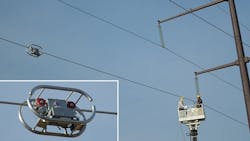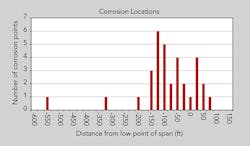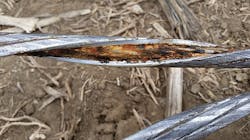Conductor Corrosion
Is there a correlation between compression connectors — a two-stage full-tension compression joint, or splice, and a two-stage compression dead-end — and corrosion in aluminum conductor steel-reinforced self-damping conductors? Nebraska Public Power District (NPPD) asked this question a few years ago after discovering some steel core wire breaks during annual line patrols.
Between September 2010 and June 2012, NPPD found six steel core failures on conductors that had been in service for 30 to 40 years; another failure occurred in April 2015. All instances involved a 954-kcmil aluminum conductor steel-reinforced self-damping (ACSR/SD) Type 7 conductor on different long spans in high-voltage transmission lines. All failures occurred in spans where either a splice or a dead-end was present and only the steel core was broken.
These failures indicated a possible relationship between splices/dead-ends and corrosion. It was unknown whether other factors such as the relationship of the corrosion with conductor motion, atmospheric condition, topography and geographical location could have contributed to the failures.
Assessing the Condition
Historically, NPPD has used age and visual observations of its aluminum wires to determine the condition of ACSR conductors. Previous to the failures of the ACSR/SD conductors, NPPD spot-checked some 50-year-old 336.4-kcmil ACSR conductors and found little degradation. NPPD assumed the same would apply for all ACSR/SD conductors. Furthermore, the absence of coastal areas with salt spray or industrial facilities near these lines contributed to a sense that any steel core corrosion would be slow, if existent at all. This sense was also corroborated by the lack of corrosion evidence on wires that had been removed during past storm repairs or other construction activities.
The 50-year-old 336.4-kcmil ACSR conductors previously mentioned were also tested. They were taken from dampened lines supported on wooden H-frame structures with 700-ft (213-m) ruling spans and sagged to 25%, 33% and 50% tension limits as follows:
- 25% of rated breaking strength (RBS) at final unloaded tension at 0°F (-17.8°C)
- 33% of RBS at initial unloaded tension at 0°F
- 50% of RBS at an initial condition of 0°F with 0.5-inch (12.7-mm) ice and 40-mph (64-kmph) wind.
The ACSR/SD failures were limited to 954-kcmil ACSR/SD Type 7 supported on tubular and lattice-steel structures with 950-ft to 1,400-ft (290-m to 427-m) ruling spans and sagged up to 25%, 35% and 60% tension limits as follows:
- 25% of RBS at final unloaded tension at 60°F (15°C)
- 35% of RBS at initial unloaded tension at 60°F
- 60% of RBS at an initial condition of 0°F with 0.5-inch ice and 40-mph wind.
NPPD wanted to determine whether a discernible relationship was present between either a full-tension compression joint, or splice, or a compression dead-end in a span and the presence of corrosion in the steel wires of the conductor. However, a sample of six failures was not enough to make a reliable determination. A larger sample size of spans with and without full-tension splices or dead-ends using reliable and meaningful test data would be needed to determine whether there was a significant relationship (that is, one with 95% confidence).
For example, one set of double circuits contained 67 splices. If the actual, but yet unknown, number of spans with a splice and corrosion was 60, the odds of finding one span without corrosion using only one sample was 10% but would increase to 96% with 24 samples. Obviously, the larger the number of samples, the higher the confidence would be in any conclusions made from the data.
Two options were known to be available to assess the condition of the steel core wires: remove sections of conductor and send them to a laboratory for testing and analysis, or use a nondestructive examination line-based device called LineVue that could produce meaningful information on the severity and location of corrosion in the steel core.
LineVue is a field-based, nondestructive inspection system that measures the remaining cross-sectional area of steel wires and detects any localized breaks or corrosion pits on steel wires. The inspections can be performed on energized and de-energized conductors. A span of 800 ft to 900 ft (244 m to 274 m) takes about 17 minutes to inspect. The device requires any conductor attachments, including bundle spacers, anti-galloping devices, aerial marker balls and other attachments on the conductor be removed. Compared to retrieving samples from the lines and testing them in a lab, LineVue can inspect larger numbers of conductors in shorter times. Using a nondestructive inspection method would enable NPPD to avoid introducing more splices in its lines and taking unnecessary line outages.
Conducting Field Inspection
The LineVue tool was chosen over retrieving field samples because of the short duration required for data collection (three days versus six to 10 weeks) and the ability of the results to indicate the condition of the core. NPPD selected 24 spans with two-stage full-tension compression joints, 24 spans without either full-tension compression joints or compression dead-ends, and six spans with two-stage compression dead-ends on a double-circuit line to test the hypothesis that corrosion occurred only in spans with either splices or dead-ends.
System conditions enabled the double circuit to be de-energized, resulting in faster inspection. A high-reach crane was used to install and remove LineVue from the line, and six spans of conductor could be inspected with each crane move.
Evaluating the Results
The results indicated 23 of 24 spans with a splice had some level of localized corrosion present. Of these 24 spans, 19 were considered to be in good or excellent overall condition with localized areas of corrosion (that is, an extent less than 50 ft [15 m]) detected on the steel core. The location of the maximum corrosion was plotted against the location in the span and indicated 21 of the 23 corrosion locations were within
150 ft (45 m) of the low point of the span. Only 16 of 23 locations were within 150 ft of the full splice. The data supported the hypothesis that a strong correlation exists between corrosion and the presence of a splice.
The data from the 24 spans without either a full-tension splice or dead-end indicated 10 of 24 spans had some level of corrosion present. Of the 24 spans tested, 22 were considered to be in good or excellent overall condition with localized areas of corrosion (that is, an extent less than 50 ft) detected on the steel core. LineVue indicated 9 of 10 corrosion locations were within 150 ft of the low point of the span. This data showed even though there was a lower number of corrosion locations and a lower severity of corrosion, the problem was not limited only to spans with either a splice or dead-end.
Finally, data from spans with two-stage compression dead-ends indicated three of six spans tested had some level of corrosion close to the mid-span location. All six spans were considered to be in good to excellent condition. Overall, the results indicated corrosion in more than 50% of the spans inspected, mainly located in the lowest 300 ft (274 m) of the span (150 ft on either side of the low point of the span) and strongly correlated to the presence of either a splice or dead-end.
In April 2015, five of the worst corrosion sections of conductor were removed from the line. Two were analyzed and tested in the laboratory at Kinectrics and two were examined in the field for location and severity of corrosion. The analysis confirmed the corrosion locations predicted by LineVue matched the actual corrosion locations.
The laboratory tests also confirmed the strength calculated using the data from LineVue correlated to the remaining strength of the core. Additionally, the predicted damage (that is, a broken strand, severe pitting, etc.) was found to be correct after the outer layers of the conductor were removed. The tool proved to be accurate in predicting location and severity without the need to remove the conductor from the lines.
Present and Future Benefits
As the conductors and steel shield wires continue to age, it will be increasingly important to know their physical condition for safety and reliability reasons, and to optimize the timely expenditures of maintenance and capital budgets. The challenge will be to determine why there is a stronger relationship between the presence of either a splice or dead-end and corrosion to determine how this condition can be managed into the future. Conductors are of primary interest because their condition often drives asset management decisions.
The inspections using LineVue provided quantifiable data for a large sampling of conductor in a relatively short period of time (three days). Corrosion severity and location in the span were provided without having to remove sections of conductor to determine the condition. Removing all 54 sections and splicing in new sections would have taken much longer. Continued assessment of the conductor using various methods will assist with maximizing conductor life and prioritizing maintenance as well as capital expenditures.
These types of inspections and analysis can lead to a better assessment of conductor health, provide data for more targeted maintenance and capital investment, and greatly assist management of the conductor assets at NPPD.
Mark Fletcher ([email protected]) is a preventive maintenance engineer with NPPD, responsible for the coordination of transmission line assessment, analysis of field line patrols and pole inspections, transmission line component failure analysis and component health assessments. He has a bachelor’s degree in agricultural engineering from the University of Nebraska-Lincoln and is a licensed mechanical engineer in Nebraska.
Les Svatora ([email protected]) is the transmission line engineering supervisor at NPPD. He has 37 years of transmission line structural and geotechnical knowledge and experience with design, analysis, construction and project management of 34.5-kV through 345-kV wires, structures and foundations. Svatora holds a BS degree from the University of Nebraska, is a certified project management professional and a licensed structural engineer in Nebraska.
Daniel F. Weyer ([email protected]) is in transmission and distribution at NPPD, working as an engineer in asset management. He holds a BSME degree from the University of Nebraska, an MBA degree from Bellevue University and is completing a MSME degree. Weyer is chapter president of the National Society of Professional Engineers and a licensed professional engineer in Nebraska.
Craig Pon ([email protected]) has 35 years of experience in the mechanical aspects of overhead transmission and distribution lines, including overhead conductor dynamics, assessment of aged transmission line components, testing of fiber-optic cables for transmission lines in the laboratory and development of LineVue. Pon recently retired from Kinectrics; he was manager of the Mechanical Test Laboratory related to overhead lines.
Andrew Rizzetto ([email protected]) received his BSME degree from the University of Toronto, where he specialized in mechatronics/robotics and vibration. Rizzetto is an integral part of research and development of the advanced nondestructive conductor assessment device called LineVue. At Kinectrics, he has day-to-day responsibilities as a project manager for conductor assessment projects, fitness-for-service evaluations, design qualification testing, transmission tower vibration monitoring and LineVue field testing services.


